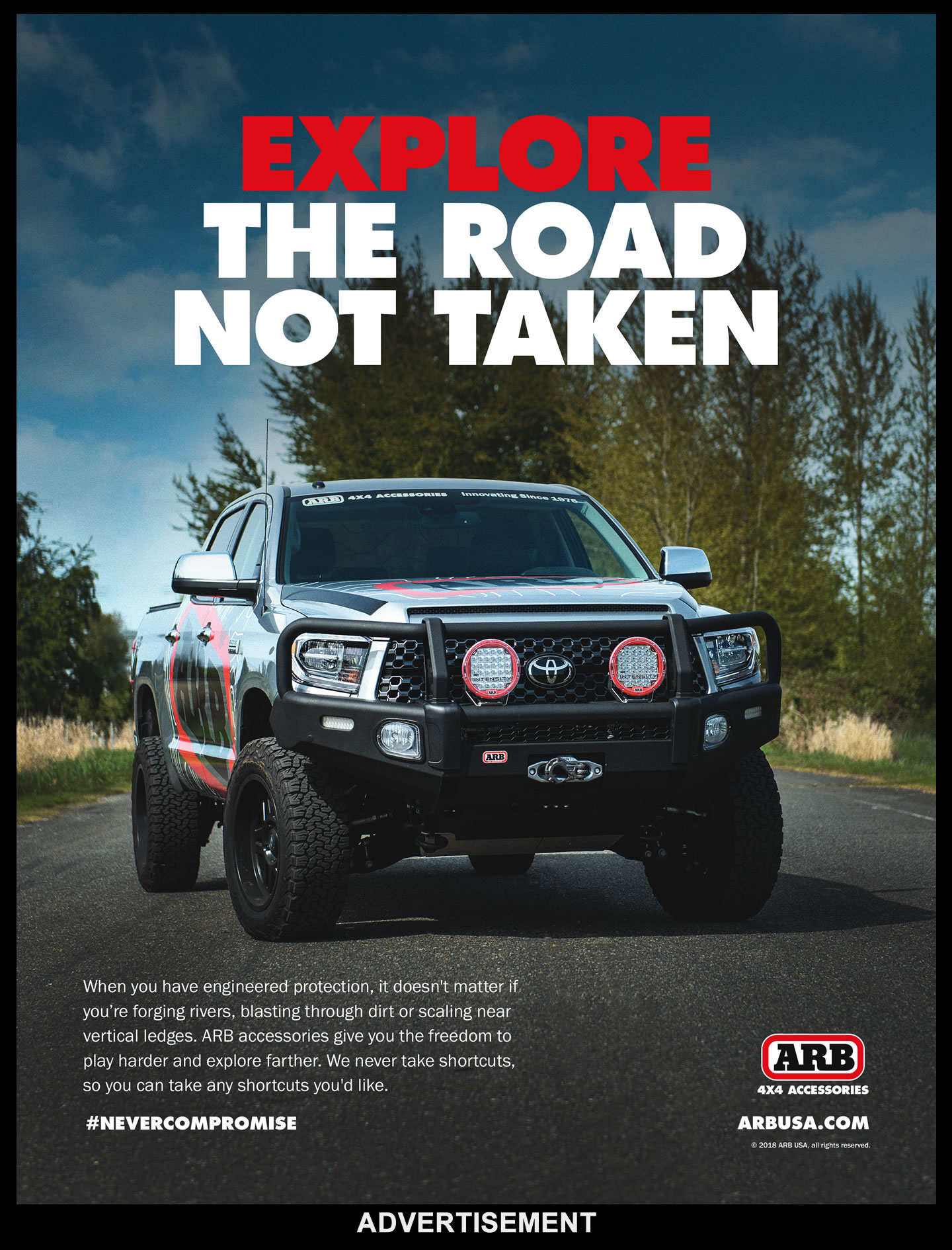Before we married, I told Lisa we were going to have a life of adventure.What better wayto live that out than to plan atrip to Alaska—more specifically,to Deadhorse, Prudhoe Bay.Formanyyears,I dreamt of traveling to the Arctic Ocean by vehicle.I had prepped my 1985 FJ-60 for years in anticipation of this trip. We researched the plentiful information on traveling the Haul Road and felt we were ready.
On May 26th we started our long trek north. Along the way, we stopped in Billings, MT to meet up with our friend Larry and his 1997 Lexus LX 450.Originally,wehad scheduled four weeks for the trip,but after 45 days,it was up to the road as to when we got home.
The Dalton Highway, known to Alaskans as the Haul Road,was constructed in 1974 to support the Trans Alaskan Pipeline. It is 414 miles in length and is mostly gravel and dirt. Surprisingly the better parts of the road are not the paved sections.
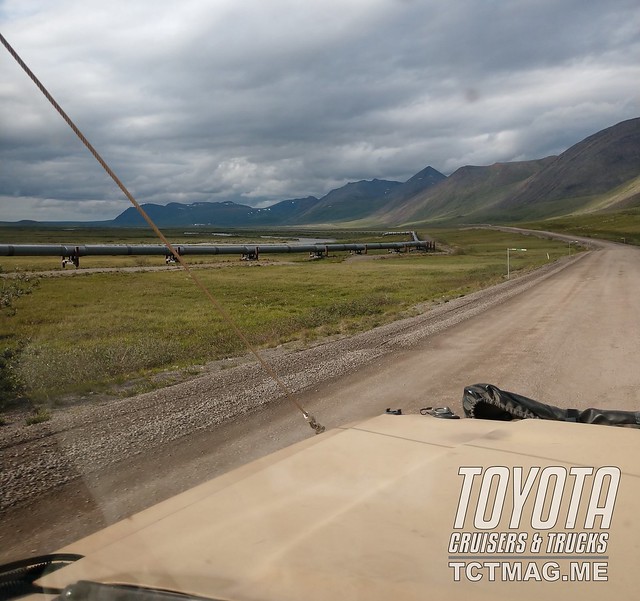
The Haul Road is a feat engineering and a marvel to behold. Road construction was completed in a mere five months and was built on a three-to six-foot high road bed with a width of 28-feet. As the road travels north, the road bed becomes higher to insulate the road from the permafrost. On these built up sections,there is no shoulderand no room for error. Also, since it’s the life line to Deadhorse,AK,the road is open all year.
The Dalton has been featured on the BBC’s Most Dangerous Roads,and for good reason. There are only two places along the highway that offer limited lodging,food,and gas: Yukon River Campand Coldfoot. The only medical facilities are in Fairbanks or in Dead horse at either end of the 414-mileroad.
Two spare tires are recommended as well as emergency equipment in case of being stranded. We had an InReach and Iridium Satellite phone for emergencies. The Mile post guide was an invaluable source of information. The BLM manages the land from the Yukon River to north of the Brooks Range. Yukon Flats NWR and Coldfoot Camp offer nice campgrounds and visitors’centers.
Leaving Fairbanks, we traveled Elliot Highway for about 80 miles. This road is paved but is subject to frost heaves that sent our vehicles bouncing. After a couple of hours, we arrived at the sign announcing the beginning of the Dalton Highway. We stopped for pictures, then headed north to Deadhorse.
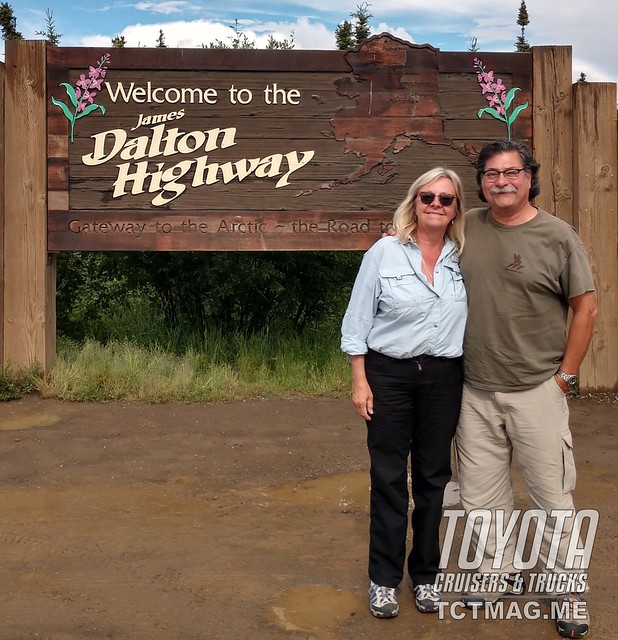
The highway was a nice dirt road as we traveled through the Boreal Forest. We soon came to the Yukon River and crossed a large bridge. At the end of the bridge was a BLM visitor center(we stop at them all). We were welcomed by Duane,a BLM volunteer from Indiana. Duane told us that only 1% of visitors to Alaska travel north of Fairbanks. He welcomed us as part of that percentage, then provided us the current road condition. Based on his advice, we camped at near by Mile 60 camp. The campsite was nice with pit latrines and the most delicious well water I’ve tasted. We settled in with a cocktail and toasted to a safe and successful trip. In keeping with my Bolivian heritage,I spilled a little of my Single Malt on the ground as an offering to Pachamama (Mother Earth).
It was easy to lose track of time with the sun shining brightly late into the night. It was past 8PM when we realized it was time to get some dinner cooking. In opening the back of my Land Cruiser, I noticed the rear lift gate window was shattered. Thankfully the window was tinted so the glass was held in place. The better part of a roll of 100 MPH tape later and the window was fixed. Despite all the warnings about the mosquitoes,we were not bothered. I fired up the Thermo cells, applied some repellent,and we were comfortable. With some beef stew in the pressure cooker, I walked around camp and visited with some the campers. A couple of adventure bikers on the return trip from Deadhorse reported the road got worse as the scenery improved. Another couple,towing a small fifth-wheel behinda Ford Ranger, was headed to Deadhorse. We met a couple from Poland driving a massive Mercedes Benz Unicat, also headed to Deadhorse.
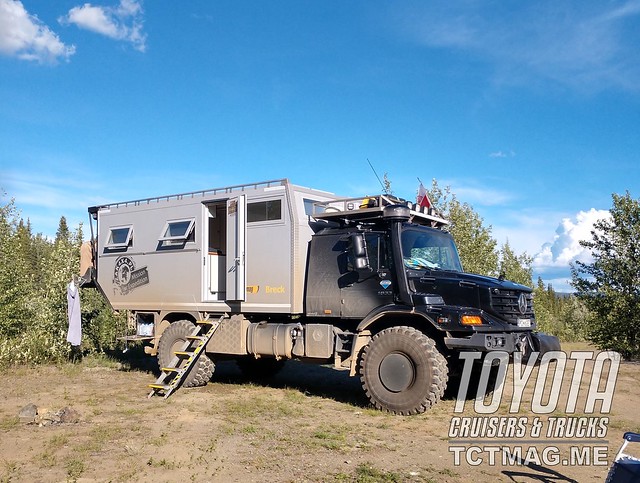
We learned earlier in the trip to set an alarm as a reminder to go to bed, so at 10 PM the soft beeping urged us to bed in the bright sunlight. We had breakfast at the Yukon River Camp. It was nice not having to rush. Other than breakfast, the menu was Chinese. Many tourists from China stay at this camp, so the menu is suited for their palate.We learned earlier in the trip to set an alarm as a reminder to go to bed, so at 10 PM the soft beeping urged us to bed in the bright sunlight. We had breakfast at the Yukon River Camp. It was nice not having to rush. Other than breakfast, the menu was Chinese. Many tourists from China stay at this camp, so the menu is suited for their palate.
Back on the road, Lisa would get on the radio and read from The Mile post. We were long beyond XM radio range,so listening to Lisa read from the guide book was better than a book on tape.
Every so often we would see a dark shape on the side of the road. As we slowed, we would be rewarded with the sight of a bear. We also saw moose,and Larry spotted a wolf dragging a kill.
We were in bear country and each night we would scout around our camp looking for signs of bear. We were ready in case of an encounter. We had an air horn, bear spray and bear bangers. Our final fall back position was a .44 mag pistol and a 12-gauge shotgun. We never encountered a bear near any of our camps.
The further north we drove, the road got worse. Due to the temperature extremes and the permafrost,the road is a series of frost heaves, which make the smooth pavement a series of sharp dips and bumps. Frozen water underneath forces the pavement up and forms these bumps.Driving on the pavement is terribly hard on the vehicle. Some of these hazards appear quickly, making it difficult to react. Series of dips worked the suspension to the max, especially with the trailer attached.
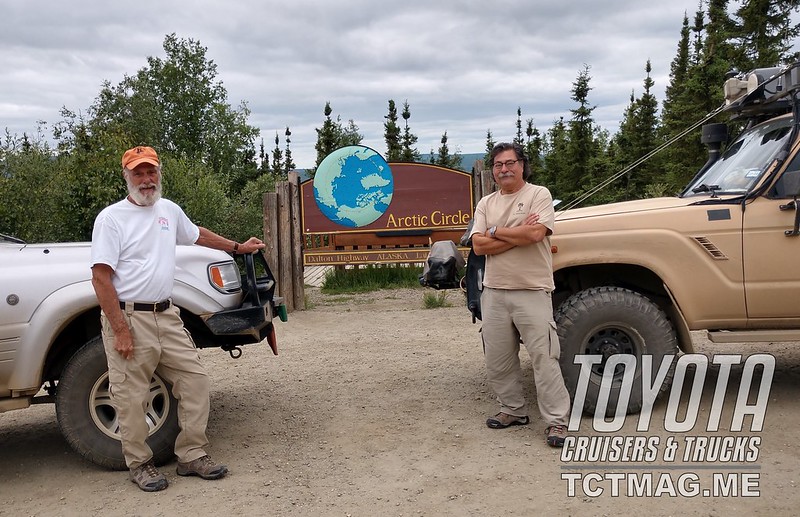
Coldfoot has a tire repair shop, restaurant and post office. There is a beautiful interagency visitor’s center that is a must a stop.This is the place to check on the weather for Atigun Pass(elev. 4,800 feet), which crosses the Arctic Circle Brooks Range and from there enters the Tundra, 129 miles above the Arctic Circle. The weather could be bad enough to close the pass as snow and ice is not uncommon year-round. I locked the FJ-60 hubs.
Our weather luck ran out when it started to rain. The calcium road became slippery and was the consistency of thin pudding. Luckily the rain and mist gave the countryside a surreal look. We passed some adventure bike riders, who looked miserable. The road was so slippery they were “pedaling” their bikes. Difficult to empathize as Lisa and I sat warm and dry in our FJ-60.
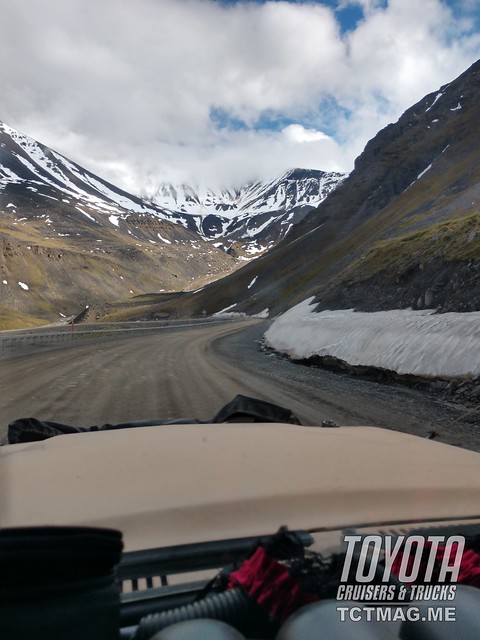
According to the Milepost, we were approaching Atigun Pass. The road was surprisingly good as we ascended the hill. I could feel some sliding and the locker working so I pulled the T-case lever into 4 high. We crested the pass and the view would have been spectacular had the day been clear. As we drove down the pass we could see where the snowpack was melting and water running down the mountain; the beginning of a river or steam. Along the road there were avalanche guns. In the winter these guns were used to preempt avalanches,which could close the road for days.
We had been driving for about eight hours and it was time to stop and relax. Galbraith Lake Campground was several miles off the highway.
As we arrived at the campground, we saw the massive MB Unicat and the couple with the Scamp fifth-wheel. We wondered how the trailer was holding up. On the back of their trailer was a shredded tire,hopefully they had another spare.
As we were looking for a spot the XM radio came to life then died out. I backed up to where the signal was and radioed Larry we had found the perfect spot.
It was still raining so I hurriedly set up the Rhino-Rack Batwing,it’s amazing how quickly I can deploy that awning. With shelter from the rain in place, we sat and indulged adult beverages to warm our stomachs. As Lisa and I were prepping dinner,the sun came out. was still raining so I hurriedly set up the Rhino-Rack Batwing,it’s amazing how quickly I can deploy that awning. With shelter from the rain in place, we sat and indulged adult beverages to warm our stomachs. As Lisa and I were prepping dinner,the sun came out.
All along the highway we were following the Alaskan Pipeline. It was really a marvel to see this amazing feat of engineering. Depending on the terrain,the pipeline was above ground or buried.The design was to allow for free movement of wildlife and to protect the fragile tundra.
We were now 140 miles from Deadhorse. We sent in reservations to the Aurora Hotel via the InReach and set up the Arctic Ocean Shuttle. All we had to do was get there.
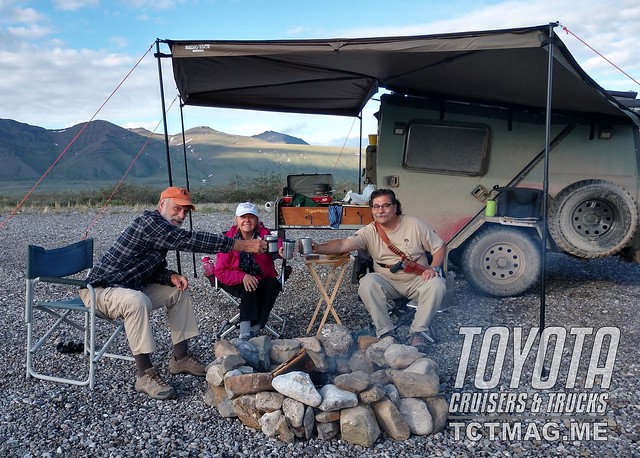
We quickly broke camp and were excited to reach our destination. As we drove we saw many musk ox lying on the tundra and feeding. These amazing animals are only found above the Arctic Circle and within 20 miles of the ocean. The ox evolved superbly to thrive in the harsh Arctic of environment.
Along the route, we spottedpump stations and scientific research stations. The Milepost strongly advises these are private facilities and there are no public services.
As we got closer to Deadhorse we could see and smell the Arctic Ocean. The trip I always dreamed of was finally going to be realized. As the miles ticked off,we started to see some tall oil rigs and suddenly our cellphones came to life when we entered cell coverage.
The Aurora Hotel reminded me of being in Iraq or Afghanistan. It was constructed of containerized housing units (CHU) and had a dining hall, espresso shop, gym,laundry, high speed Internet and satellite TV. Other than the Internet, everything was included in the price of the room. As we checked in, the front desk advised us to get lunch first before the chow hall closed, giving me flashbacks of being in a DFAC in Afghanistan. The entire Deadhorse complex reminded me of being overseas. Not a real surprise as the oil companies have been building cities in the middle of nowhere for decades.
We drove to Deadhorse Camp for the shuttle and checked in. Sure enough, we met up with the Polish couple and the couple pulling the Scamp fifth-wheel. They told us the trailer was rattling apart and they needed to get to the hardware store and make some repairs.After a few minutes we all got on a shuttle bus and headed to the oil fields and to Prudhoe Bay. Our guide told us how the oil was extracted from the ground,and the massive oil rigs were self propelled and drove out to the oil sites on ice roads. He told us that most people work two/three weeks on and one week off and were flown in and out on oil company passenger jets.
We finally stopped at a small finger of land jutting into the water complete with ice flows. Everyone was excited as we exited the bus and one woman was even stripping off her clothing as she ran to the water and dove in.
Lisa, Larry and I took off our boots and rolled up our pants and gingerly waded into the frigid water, which was so cold my feet went numb immediately and then began to ache.Larry and I had found Hawaiian shirts at Goodwill in Fairbanks and thought it would be fun to wear them while wading in the Arctic Ocean. We did get a couple of smiles and comments.
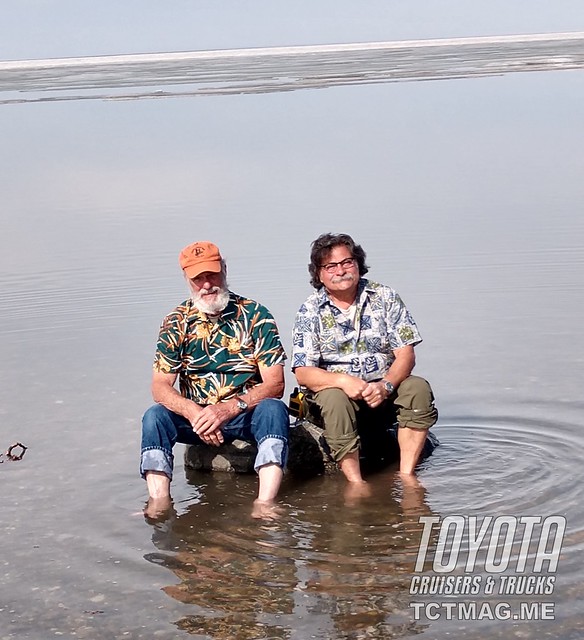
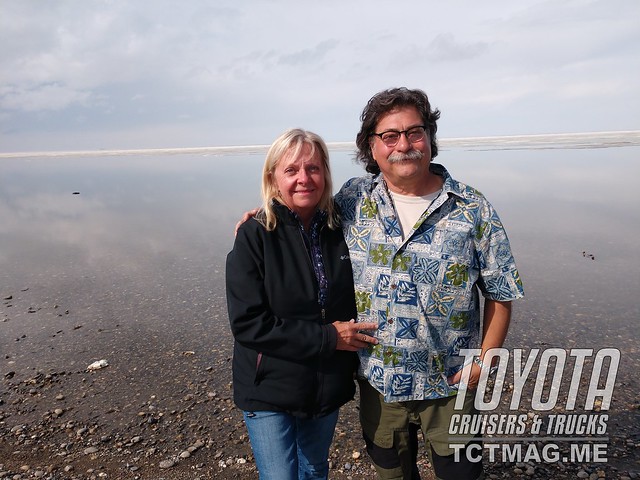
Back at the hotel it was time for well-deserved showers after several days on the road.Lying in a real bed,watching TV,and catching up on the news was quite a luxury. Soon enough it was time for dinner chow and we all had a really good meal. The only thing missing was a bar—the entire camp is dry. Good thing I had my emergency flask.
Before going to sleep, I queued up several Netflix videos to download and drifted off to sleep in disbelief that we made it.
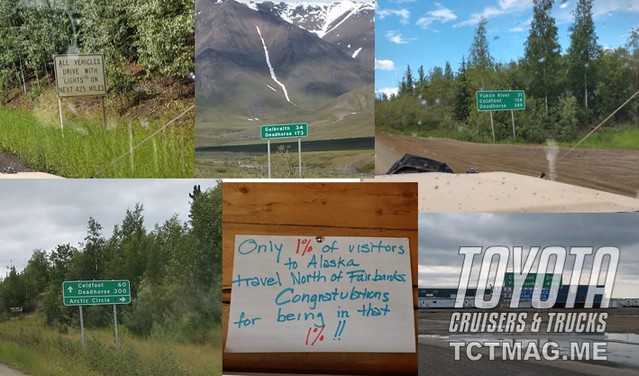
We awoke up to a dark dreary rainy day. Freshly showered and wearing clean clothing,a little rain was not going to break our great spirits. We headed out and visited the must-see hardware store before topping off our gas and started to head South. It all seemed so surreal now that we were heading back to Fairbanks. We had driven so far and for so long and now we were heading back. Not back home because we had another date with the Arctic Ocean in Canada. But that is another story.
Driving on the dirt was much better.
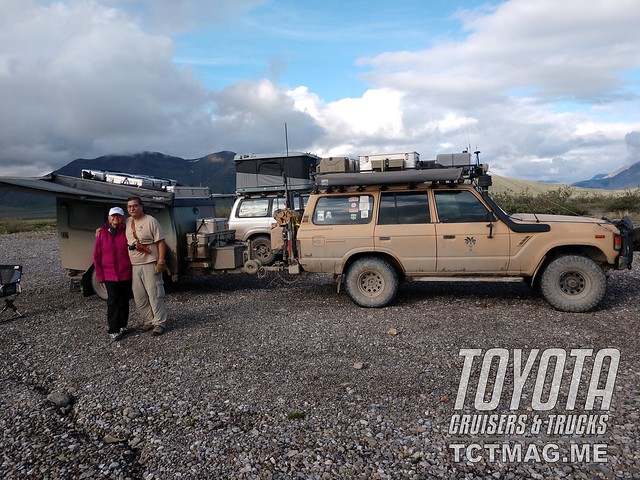
To get your copy of the
Fall 2018 Issue:
Follow us on Facebook, Twitter, and Instagram to get up-to-date industry news, events, and of course, amazing adventures, stories, and photos!











